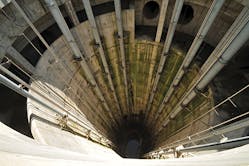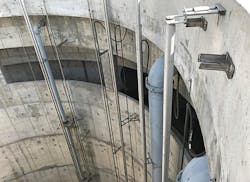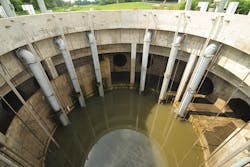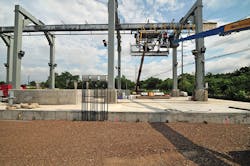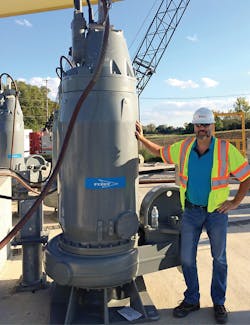This is part two of a two-part series. Read Part One here.
The Sweet Smell of Success
Driving through many older cities, it is not unusual to spy a billboard picturing a dejected homeowner under the bold headline “Flooded Basement?” The question mark is significant, because basement flooding is almost always mystifying to the homeowner. Deb Leonard, communications manager for the Metropolitan Sewer District (MSD) of Cincinnati, OH, narrates the typical scenario: “During a heavy or extended rain, you notice that there is water coming out of the floor drain, or that it is already up. It’s hard to tell why. You don’t know what it is, or how it got there.” To paint an even worse picture, sometimes it’s not so simple as opening the windows and waiting for it to dry out. “Imagine going in your basement and you’ve got a couple of inches of sewage and it doesn’t smell so good and your stuff is ruined,” says Leonard. Up until 2004, homeowners in Cincinnati would have been left to their own devices to deal with such catastrophes, but recently, new devices supplied by the MSD are helping owners cope.
As part of the city’s consent decree to reduce combined sewer overflows, the MSD administers a Sewer Backup Response Program that provides help with cleanup, handles damage claims and reimbursements, and installs backup prevention devices on homes that experience sewer backups from the public sewer system. Leonard explains the program: “If you have a sewer backup due to inadequate capacity in the public sewer system, or a blockage that was caused by the public sewer system, the MSD will pay to compensate for the damage, and if it happens two or more times over a span of five years, we’ll put in a prevention device at no charge to the homeowner.”
A Common Problem
It’s a fairly common predicament. “We’re a pretty old city. In August 2016, we had a huge storm and we had over 2,000 backups, which is an unbelievably large number.” However, says Leonard, “Prior to that, we had a storm here or there and there would be 20 or 50 reported backups in the different parts of the county that got hit. But this storm was massive, and it just hung in one area with four inches of rain.”
Statistics put out every month by the agency indicate between 3,000 and 5,000 reports of potential sewer backups in a year, but, says Leonard, “Only a fraction of those end up being a sewer backup from the public sewer. They are more frequently due to overland flooding or issues related to private plumbing or the building’s private sewer. Only between 10 and 20% are truly issues caused by the public sewer.” But that’s still a large number.
The program the MSD put in place to address the problem is unusual, says Leonard, because the utility is putting its public utility device on private property, potentially wired into household electric service. The homeowner is not charged for the installation of the device, which “can be quite pricey,” but if the device requires electricity to operate the homeowner will have to provide the electricity.
The process starts with an investigation, she says. If basement flooding is reported, the MSD will send a crew out to investigate. “If the person is home, they go into the house; if not, they do whatever assessment they can looking at manholes and elevations,” she notes.
If the cause of the flooding is determined to be sewer surcharge, the MSD performs a site survey and designs a customized solution for that specific property. Contractors then perform the installation of one of a variety pumps or valves, and “from then on we’re in contact with the homeowners for maintenance of the pump,” she says. To provide the customizable solutions sought, there is a list of different pumps and solutions used in the program, and each property is targeted with a special solution tailored to the circumstances causing the backup. Since the program began in 2004, the MSD has cleaned more than 6,000 properties and installed more than 900 sewer backup prevention devices for individual properties. “Our understanding is that none of them has failed,” she says.
An Application for Inundation
Keith McHale, an engineer and project manager with Environment One Corporation, says his company has been supplying homeowners enrolled in the Cincinnati program with E/One Grinder pumps via arrangements with local contractors as a solution to their basement flooding issues.
He explains: “Our pumps are an application to the basement flooding problem, but that’s not necessarily the primary application where they are used.” He says that for the most part they are a type of pump frequently used in wastewater treatment facilities, where the objective is to grind down the particulates in sewage to allow it to flow through the treatment stream. When the grinder pumps are used in a low-pressure sewer system, the application consists of a grinder pump basin on each individual property affected by the overflows. These grind up the wastewater solids into small particles and provide 80 psi discharge of the waste into a small-diameter, flexible high-pressure hose.
According to McHale, there are two causes of basement flooding. One is wastewater flowing into the basement from the gravity sewer system, and the other is groundwater seeping into the basement. The grinder pumps can be added to address the former.
He says that when an inundation of rain and stormwater exceeds the wastewater system’s capacity, the water backs up over the service laterals that run from the street up to the property, and that if the level gets high enough, it backs into the home and floods the basement at the head of the line. “The typical solution that you have on a gravity sewer system is a backflow prevention valve,” says McHale. “If the water level in the lateral is greater than in the home, it closes the valve. The problem with that is that no wastewater within the house will be able to be discharged into the gravity sewer system. The valve keeps wastewater from going back to the house, but it also prevents the homeowner or business from using their wastewater system.” Another complication of check valves, according to McHale, is that they “can be a little expensive, and there can be situations where the valve does not close all the way. There can be toilet paper or obstructions, and it can give a false sense of security.”
He says the E/One Grinder pump has not only a built in check valve that prevents the sewage water from backing up into the house, but also a pumping system, so homeowners can still use their water structures and the grinder pump will be able to send household wastewater into the gravity sewer system “even though the gravity sewer system is surcharged.”
A 1-horsepower grinder pump has the capability to discharge up to 80 psi, he notes. “Even if the gravity sewer is surcharged and over capacity, the pressure of the sewer would still be below 80 psi, so the pump would still be able to discharge into the surcharged gravity sewer.”
The system has a lot of versatility to solve a variety of problems following a simple principle. “We basically make one pump with different basins. Some have two pumps per basin, but basically it’s the same pump with varying basin configurations.”
It’s a solution to a widespread issue. “The biggest problem is the biohazard, because it is wastewater. The second problem is property damage. Very few basements are empty,” he says, meaning people suffer significant losses when overflow comes into the home. “Depending on how bad it is, if it gets to be a couple of inches high you get into drywall damage, and rugs would have to be torn out because of the biohazard. From the City’s perspective, it is an overflow, so there will be financial penalties on the utilities because wastewater is not supposed to come out of the pipe into the environment.”
A Big Jump for Ohio
“We are at the upstream end of the watershed; we don’t have really so much of a flooding problem, as whenever it rains, we get the high peak flows and it overloads the sewers. Because we had combined sewers, we needed somewhere for all that flow to go,” says Jeff Coffey, director of water practice for DLZ. He said the City of Columbus, OH, “looked at all kinds of options. They are separating sewers wherever it’s feasible, but it was very difficult to do that in the downtown area. They needed a relief sewer to handle all the combined sewers to eliminate combined sewage from getting out into the river.”
Several years ago, the City began planning for a new combined sewage overflow prevention system. During the design process, Coffey became the project manager. He describes the condition of the city’s drainage system. “Columbus has combined sewers, which enter the existing large-diameter sewer. The main existing sewer was called the Olentangy Scioto Interceptor Sewer, or OSIS. It was built back in the 1930s as a combined sewer. Through the downtown area, where each of the sewers feed, if the OSIS was full it would back up. There was a regulator there, and it would go over the weir and eventually overflow into the nearest storm sewer and outlet to the river.” These overflow conditions had to be addressed per the City’s consent decree, and Columbus began work on a new system called OSIS Augmentation and Relief Sewer (OARS) to solve the issue.
“OARS gives the combined system a different place to overflow to,” explains Coffey. “It now goes into our 20-foot-diameter tunnel that takes it four and a half miles south to the treatment plant, and the city treats everything it possibly can.” In the case of a rain event that reaches the maximum capacity of the treatment plant, a headworks at the front of one plant can divert flow to Southerly, a second treatment plant. “We pump as much as we can into the existing plants. If OARS keeps filling up, once the tunnel is full the pumps shut off, the shafts fill up, and then it can actually flow by gravity to the plants if they have any more capacity.” On the other hand, he says, if the plants are at full capacity, “which is usually the case when that happens, the water will overflow the weir and go out into the river, but only after both plants are at full tilt.”
He says, “When the event is over, we will use the pumps to dewater the system. Dealing with a pretty wide head range was one of the challenges, because the tunnel is almost 200 feet deep, so when it’s full there is very low head working against our pumps; you don’t have to pump it very high at all, just about 10 or 15 feet. But when the water level is at the bottom in the tunnel zone, it requires about 180 feet of pumping head. Usually such a wide variation in the pumping head would require different sets of motors and different sets of impellers.”
Because of that situation, he says, “It was kind of difficult to find pumps that were just right for this job. What we ended up doing is using two kinds of pumps—one for the shaft level and a different model for the higher levels—and we use adjustable-speed pumps, so as the level changes you can slow the motor down or speed it up.” To handle such a wide variation in pumping head, Flygt pumps from Xylem were selected.
At the main tunnel level, there are four large pumps that can handle those flow ranges. The upper units can pump 20 million gallons per day (MGD), and the two units at the bottom can pump 15 MGD, which Coffey says gives the system a maximum capacity of 60 MGD, “which is pretty good—it’s almost the daily flow that one plant gets,” he notes. And it meets one of the goals of the pumping system: to have the ability to dewater the tunnel in just two days, so that the tunnels can be made ready to use again for temporary storage in case the next storm comes right on the heels of the first.
The pump system has eliminated the bulk of the overflow problem, he says. “Now that we have OARS on line, on average in a normal year it will activate and fill up about once every three weeks. The net result is almost 2 billion gallons of combined sewage are getting treated instead of overflowing to the river every year.”
Making a Big Splash
With so much water moving, it was important to manage certain side effects. There are six shafts. Four of them are designed to receive flow from relief structures that are designed off overflow points intercepting flow and bringing it into the tunnel. From each one of those shafts, the flow drops about 150 feet, generating a great deal of momentum. “What we’ve designed is a tangential inlet, which directs the flow to a pipe that goes vertically down,” says Coffey. “It basically spins the water around and dissipates energy and lets the air flow back out to the surface instead of dragging air into the tunnel. The key is dissipating the energy, so when the water drops 150 feet it doesn’t erode out the bottom of the shaft.”
One can imagine the splash of millions of gallons of water dropped down a 150-foot shaft into a 20-foot tunnel, as the designers on the OARS project certainly did. Such a splash could send water surging through the tunnel sloshing water around with unintended consequences. The designers planned ahead for a solution. Coffey explains: “The shafts are 16 feet in diameter, and we built them within larger shafts and use the rest of the space as a surge suppression system, so if any surge waves slosh through the tunnel as it came up the shaft, it would have somewhere to burp over. It goes over a weir, and we use the bigger shaft as a surge chamber to catch any flow that might be washing up so it doesn’t impact all the other sewers that are connected to it or shoot out as a geyser at the top of a manhole.”
He adds, “We have pretty significant variation in the flow rates and the depths that we had to pump, so the City needed submersible pumps that could work in the wide range of conditions.”
For the project, Xylem provided four 800-hp Flygt CP3351.995 submersible pumps and two 450-hp Flygt CP 3531.960 submersible pumps. The four 800-hp, 15-mgd adjustable-speed pumps work at the tunnel level, and the two 450-hp, 20-mgd pumps work at the shaft level. In addition, the installation includes two Flygt NP3301.095 grit pumps. “When the flow from the tunnel enters the shaft, the first two chambers where anything can fall in, it can settle out to a grit chamber. At the bottom of each grit chamber there’s a pump. Those are 1 mgd and 100 horsepower; they’re smaller pumps, but they are designed to pump the grit and jockey flow for small rain events to the treatment plant. They serve somewhat like a sump pump in the house,” he says.
“There are still occasional overflows down at the plants, but now it’s only the very intense rain events that cause overflow.”
A Deep Dive
“The City of Columbus had a history of work with Flygt pumps and was pleased with their product,” says Coffey, but one of the features that caught his attention in favor of Flygt was the deep lift installation system. At the time, nine years ago, “This was the only manufacturer that had a good system that we could see working” to raise and lower such massive pumps.
“They have components that are designed specifically for these large pumps, to be slid down on guide rails, and they have a special deep lift mechanism that supplies support when you’re raising or lowering the pumps, so when they slide down there is a lot less tendency to sway and cause damage to the guide rails,” he explains. “It’s a pretty long process, because you’re lowering them so far you have to run the crane at a very low speed just so you don’t damage the guide rails.”
Xylem has also been good to work with in other ways, he notes. The project spanned several years, with a considerable lapse between the time the pumps were built, tested, and delivered and when they were installed. During the interim the pumps waited in storage. “Xylem was helpful in figuring out how we could do an extended warranty, and they provided advice on what kind of maintenance we should do to make sure the pumps stay good while they were in storage. We were able to work with them and get monthly inspections to make sure the impellers respond, since they were lying on their side. They took care of all kinds of little details.”
A Leap of Progress
“The downstream shaft is an open shaft. It has a parapet wall around it, and you can walk up to the edge and look down into the wet well and see the water and the baffling that was constructed to divert the flow around it into the pumps.” Although it sounds almost like it would make a curious tourist attraction, Coffey says it’s behind fence, inside the gates of the sewage treatment plant where certain less-attractive odors might hold sway. Nevertheless, he says, “I always enjoyed looking down. If you’re at all afraid of heights, you’ll get that queasy feeling in your stomach. I look down, then I tighten my hard hat real quick. Don’t drop your phone down there taking a picture,” he jokes.
On a serious note, Coffey says OARS has sparked a lot of interest from other municipalities looking to deal with CSOs. “I’ve given a few tours myself. Louisville is looking at pump station options, and a couple of other cities have looked into it as well.”
The system has been in operation officially since July 2017, and since then, says Coffey, “We’ve been learning all the fun tweaks with the pumps.”

